Broadway IC Crossing
 |
Louis Marre Collection |
This eastbound Frisco train is being led by F3s #5024 and 3 sisters as it crosses the IC passenger main. |
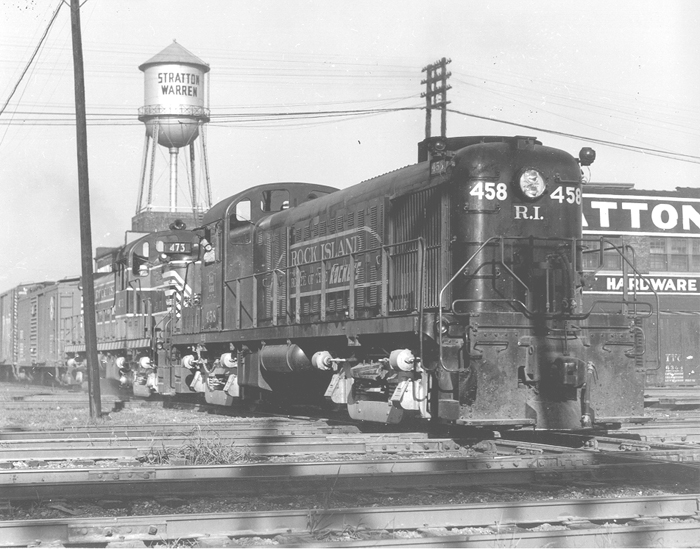 |
Louis Marre Collection |
| Here we see two RS3s crossing the IC passenger line as they move eastbound on the NC&StL to their own 4th Street yard. |
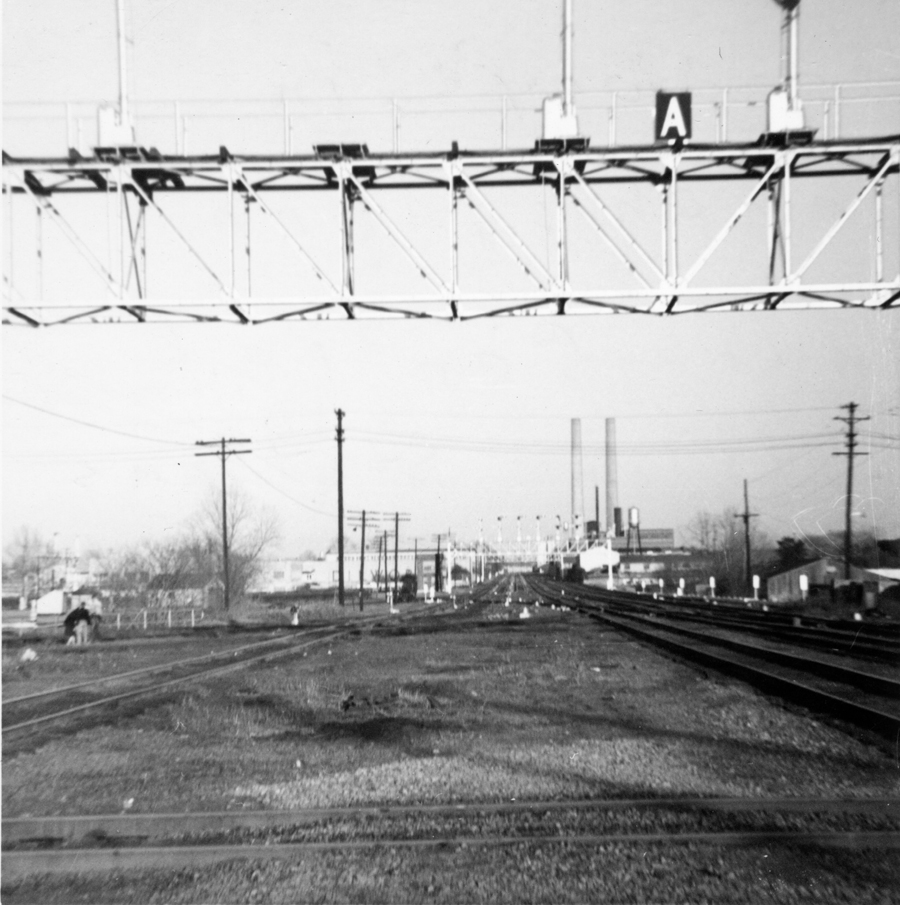 |
| IC Brakeman Greg Miller Photo |
| This view is looking east down Broadway from the IC crossing. This photo was taken about 1963. Note the large power plant on the south side of the tracks. |
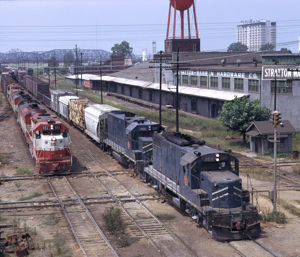 |
Photo by David Johnston |
| Frisco and Missouri Pacific freights proceed across the Illinois Central crossing in this view from the semaphore signal bridge. Note the coonskin herald on the nose of the Frisco GP38. SLSF #651 is the only GP38 with the herald on the nose. Also note the traffic light that guards this crossing, controlled from the gray switch shanty. |
-&-SSW-EB-5.73.jpg) |
 |
Photo by David Johnston |
A southbound Frisco train with UP power and an eastbound Cotton Belt train meet a northbound Frisco train at the Broadway IC crossing, 5/73. |
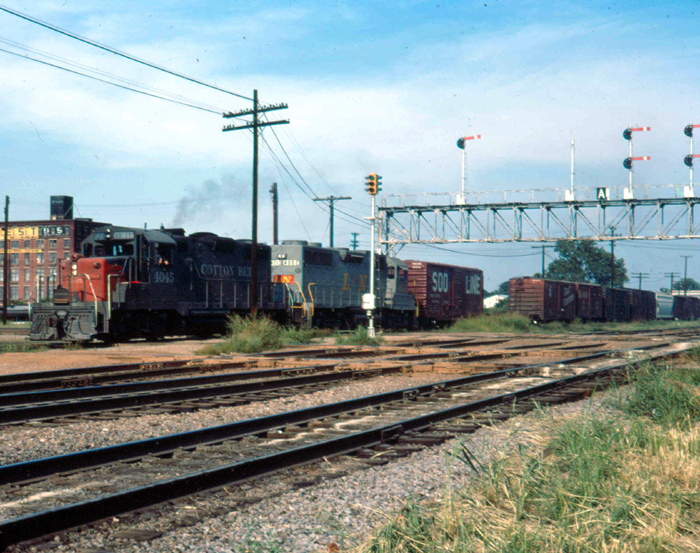 |
Photo by David Johnston |
A westbound SSW with GP20 #4045 passes under signal bridge A at the Broadway IC crossing, 8/70. |
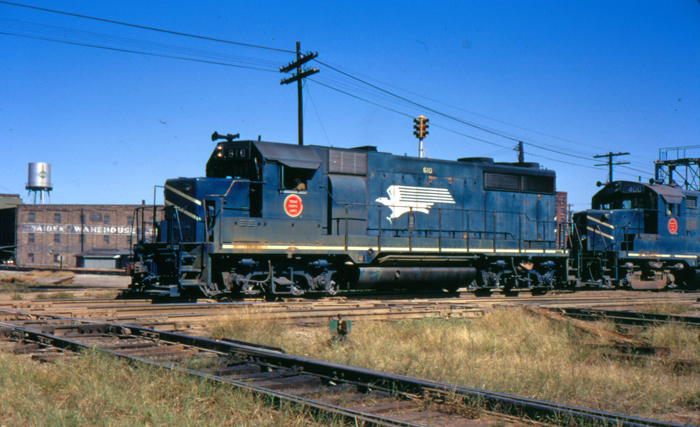 |
Photo by David Johnston |
A westbound MP GP35 crosses the Broadway IC crossing, 10/70. |
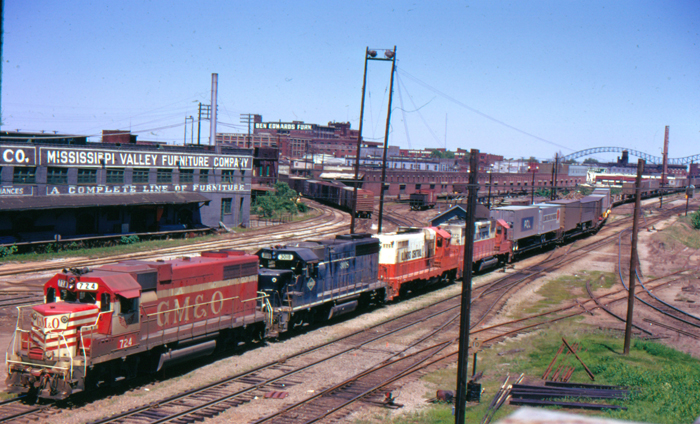 |
Photo by David Johnston |
| Southbound IC train led by GM&O GP38 #724 passes through Central Station as it prepares to cross Broadway, 5/73. |
 |
Photo by David Johnston |
| Southbound IC train led by GP28 #9447 passes through Central Station as it prepares to cross Broadway, 5/73. |
| Interchanges between Railroads
The Rock Island would come in with a train that would have blocks for the Frisco, IC, Southern, and L&N, as well as a Memphis proper block (for a while, the Southern business on the RI was good enough to warrant a separate Southern runthru between Sheffield, AL and Little Rock). Prior to the train's arrival at Briark, the yard crew would leave 4th St yard with a light engine and go to Briark to meet the road train. The road crew from Little Rock would pull up on the double track at Briark beside the yard engine, and they would swap out. The yard crew would take charge of the road train, pull up until the rear of the train with the Memphis propers and caboose were at the signal at Briark and the road conductor would make a cut. The yard crew would then come up on the bridge with the bulk of the train, and the road crew, now on the yard engine, would go get the rear of the train and take it to 4th Street yard to tie up and take rest for the return to Little Rock. The yard crew would first deliver the Frisco block in the H-B Auxiliary track that once ran between Ky St and the east end of the Harahan Bridge. They would then get the IC block and deliver it to the IC at South Yard, then return to the train and head to the L&N and Southern. That was one of the more unique operations around Ky St in the 1970's. Also the Southern would deliver to South Yard by pulling up into Central Station and then shoving south across Broadway into South Yard. On occasion, something would be in the way in the station and the Southern would pull toward the Harahan bridge and shove across the Frisco into South Yard. One day the IC and Southern were trying to deliver to each other at the same time. The Southern had to pull "high" to let the IC get out of the station and around the northeast wye to get to the Southern. Then Broadway got busy and the IC could not get across the L&N the short distance needed to get to the Southern westbound main. The Southern, meanwhile, was blocking the crossings to the then-new high dollar homes on the river bluff, which resulted in a call to the Memphis Police Dept. The police saw the IC engines sitting on the Carolina St overpass and went to question the crew. The foreman on the IC job (Zack Curlin) told the cops that he didn't have those crossings blocked. When the cop asked who did, Zack told him Buster Brown did (Buster really was the foreman's name on the Southern job). The cop thought Zack was being a wise guy and told Zack, "And I'm sure your name must be Donald Duck." It took a little while to get it all sorted out..... Some of the IC yardmasters at South Yard were real characters. One of my favorites was Billy Joe Davis. Huey was another real character. When you look over the bridge on McLemore St at the field that used to be South Yard, it's hard to believe that was a busy place 24 hours a day. There was another time the Cotton Belt was pulling into South Yard and got on the ground. The yardmaster (I think it was Billy Joe) saw it happening and started screaming on the Cotton Belt radio "BIG HOLE IT COTTON BELT - YOU'RE ON THE GROUND!!!!" I think every Cotton Belt crew between Jonesboro and Pine Bluff started to put their trains in emergency. The Frisco also delivered to South Yard. They had a job that came from Tennessee yard each afternoon and their main task was to deliver to the IC at South Yard and deliver and pull the RI interchange from H-B Auxiliary track at Ky St. I rode with that job several times. A fellow named Bill Hart ran it for a long time, and Harold "Hard Head" Coleman was the foreman on the job. I'm sure all that crew is retired now. I remember the IC going to the Frisco in the morning, usually around 10 am. Eventually the IC and Frisco (maybe BN by this time) worked out a reciprocal interchange between Johnston Yard and Tennessee Yard with the Frisco delivering to and pulling from Johnston Yard 6 months of the year and the IC doing the delivery and pulling the other 6 months. They still travelled the main lines thru South Yard however. This started as South Yard was being downgraded, but I can't recall a timeline. Whoever thought we'd be reminiscing about these as the "good old days?" The IC for a while would deliver to the MoPac at Huling St at the north end of the old Frisco Georgia St yard on the river bluff just north of Ky St. The nightly MP Georgia St switcher would pull the interchange. I think the MoPac used to deliver to the IC via the old route from Sargent Yard to East Jct, which has been torn out for a number of years now. Most of the IC-MP interchange was handled in the form of a runthru train, with MP supplying the power. I got photos of the MoPac LMI (Little Rock- Memphis - IC) once in the early 70's with MoPac F7's doing the honors. Unfortunately that was on an Instamatic with print film. There was a time during a downturn in business that the runthrus were cut off and the MoPac would come out of Sargent Yard with the interchange, run around it on the Bridge, and go then to the IC (can't remember if that was to South Yard or Johnston Yard). I'll never forget the day they had cut off on the bridge and were taking the engines to the crossover at the west end of the bridge, and their cut started to roll away down the hill back toward Broadway and Sargent Yard. I saw what what happening and told the foreman Johnny "Hook" Duvall, who had dropped off at Ky St) that his cut was running away (Johnny got his nickname "Hook" because of his big hook nose. He could smoke a cigarette in the rain and it wouldn't get wet). I called the engines on the radio and they reversed direction and started chasing the cut. It rolled past Ky St PFF (pretty frickin fast) and thankfully the IC crossing was clear. All Hook could do was watch as it went by, and the engines right after it. The cut finally rolled to a stop on Broadway somewhere up arond Three States Supply. Fortunately no one got hurt - but there were lots of questions asked and lots of skidmarks in a lot of sets of underwear, including mine. There was a tie gang working on one of the Southern mains near old Tower 17 and they got to see it all too. Even the Southern management got in on the question session. |
| Contributed by Steve Forrest former MP KY St. operator |
| The ICG originated transfer jobs at Johnston Yard and South Yard. Frisco, Mop and Rock Island cuts tended to be marshalled at South Yard, while Southern and L&N cuts were built at Johnston or E Yard, east of the Main at East Junction. There was no hard and fast rule about which track or specific yard was used, only with expediting the movement. We did build our cuts for North Yard at South Yard. However, these were usually for industry moves, not necessarily interchange ones. Sometimes we would build cuts for Woodstock at North Yard, but that was not very common. Hollywood Yard took care of the industries and marshalled cars for the industries in North Memphis, including the Rabbit Patch job. The Hollywood job carried cars to Johnston and returned with the industry cuts for North Memphis. Pretty much all of the industry cuts were made up at Johnston or South Yards. |
| Contributed by Robert Tomb formerly with IC/ICG |
Other IC Crossings with or without towers |
| East Junction Interlocking Tower |
built 1903 Saxby & Farmer machine (Mechanical)
10 working levers, 6 sp. sp. (meaning???), 16 lever frame. (as of
1950) |
Aulon Interlocking Tower |
built 1913 General Railway Signal machine 36 working
levers, 29 sp. sp., |
L&N crossing and Union Railway crossing |
(both just south of North Yard) - gates |
West Junction |
no interlocking (or actual crossing) |
Leewood |
shows interlocker, but no details. Could be automatic
by 1950, or else operated by L&N |

Home of THE ARKANSAS SCRAMBLER
For questions, email arkyrail at outlook.com